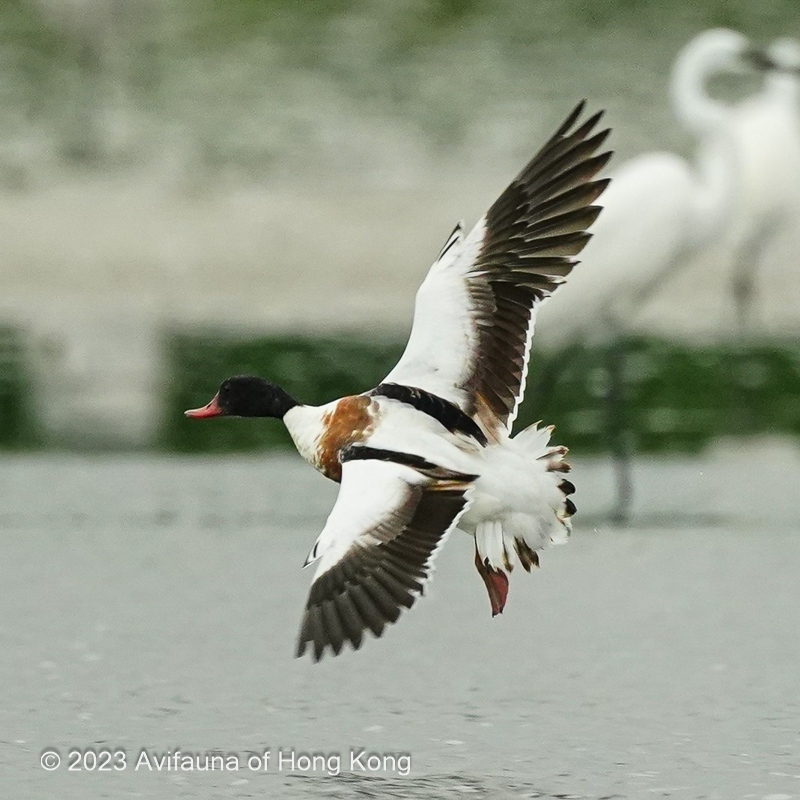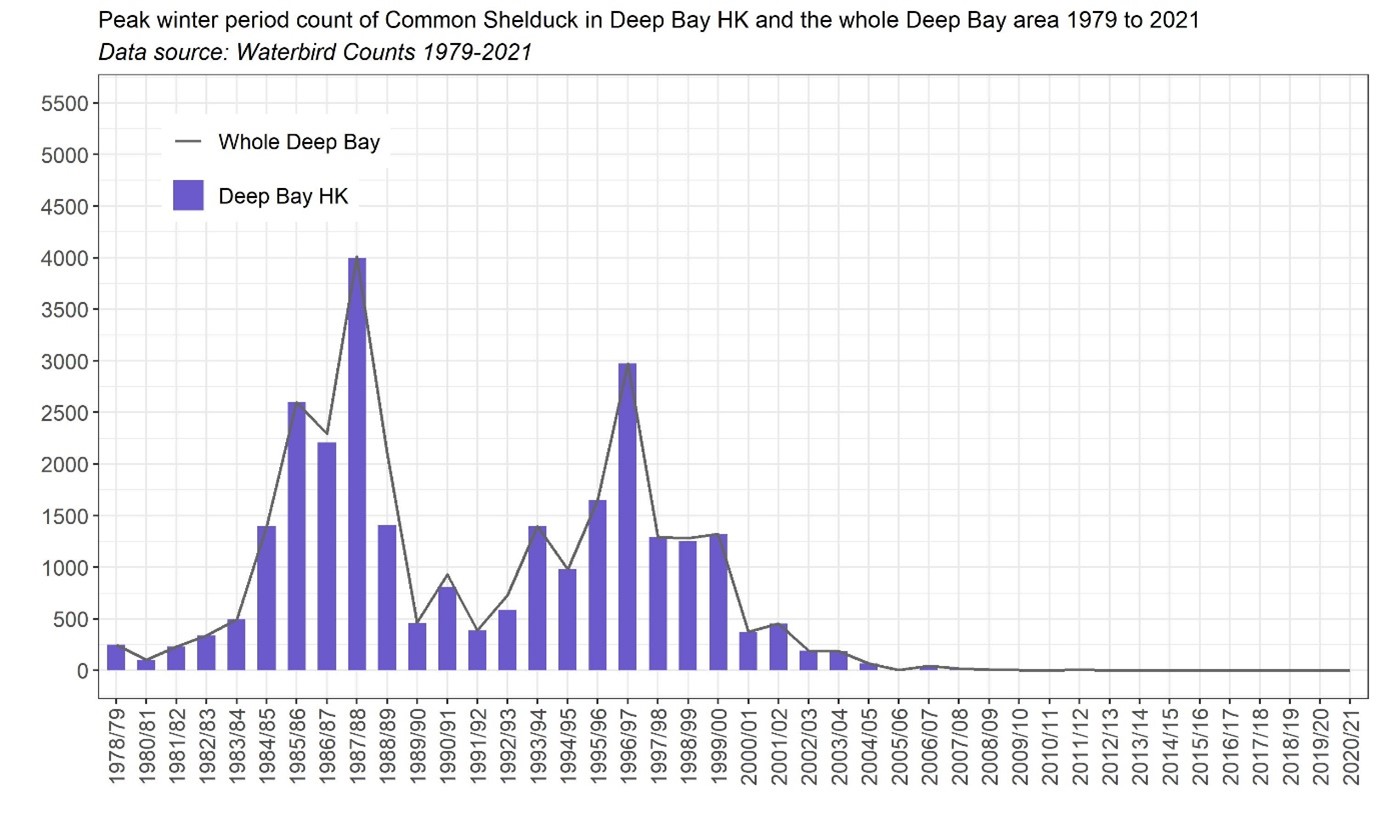Common Shelduck Tadorna tadorna 翹鼻麻鴨
Category I. Once common to abundant winter visitor, but much declined this century and now a rare winter visitor.
IDENTIFICATION

Dec. 2021, Michelle and Peter Wong. First-winter.
55-65 cm. Typically, a highly distinctive duck due to its large size and striking pattern. Plumage mostly white with orange-red bill, very dark green head and neck, orange chest band extending back to mantle, black scapulars, primaries and stripe down centre of belly, iridescent green secondaries and white wing coverts. Male has knob at base of bill; which is much smaller or lacking on smaller female; latter has duller bill.
Juvenile has white face, chin and fore neck, grey scapulars, no chestnut band and grey hind neck. This bird is moulting from juvenile to adult-type plumage.

Jan. 2008, Kinni Ho. First-winter.
Young birds have white trailing edge to wing.
VOCALISATIONS
A vocal species. Calls include a rolling, slightly throaty and repeated ‘krrr’ that sometimes ends in a ‘ka-ka-ka-ka...’ crescendo. The latter may also be uttered alone.
DISTRIBUTION & HABITAT PREFERENCE
Apart from two at Shuen Wan on 6 December 1993, all records have been in the Deep Bay area. The wintering flock remained almost exclusively in the intertidal areas of the bay itself, and the rare occasions on which it was seen in the ponds of the reserve involved late-departing or migrant individuals in spring joining other birds at a high tide roost.
OCCURRENCE
Previously a common to abundant winter visitor to the Deep Bay area, albeit somewhat erratic in regard to the numbers present, Common Shelduck is now rarely recorded.
La Touche (1931-34) noted that Common Shelduck was a common winter visitor to the coast of eastern China and occurred from November to February in large flocks at Swatow (Shantou) in the extreme east of Guangdong. The first record for Hong Kong occurred on 4 February 1956 (Walker 1958). Numbers recorded subsequently were low and erratic until the mid-1970s, with no records at all in the first half of the 1960s.
Until the 1974-75 winter period, the highest count was 115, but beginning in winter 1975/76 numbers rose. Figure 1 illustrates the subsequent rise but also the erratic nature of its occurrence, as numbers rose sharply from winter 1984/85 to reach a peak of 4,011 birds on 17 January 1988, the highest on record in HK. This increase was also reflected in the first records in summer and relatively high numbers remaining rather late in the spring from 1985 to 1987. Subsequently there was an equally sharp decline to 387 in winter 1991/92, followed by a further sharp increase to a peak count of 2,972 in winter 1996/97. The following three winter periods brought peak counts of approximately 1,300 birds, but winter 2000/01 saw the beginning of another sharp decrease to 18 in winter 2007-08, and then no more than nine birds until 2012/13 when one was present until 2 March. The next record was of one on 26 February 2020 that was last seen on 18 March.
Until the late 1980s, Common Shelduck was a winter visitor from the second week of November, but after 1989 there were no records prior to 27 November. Extreme dates, excluding summer records, are 22 October 1999 and 29 May 1980, though even during the 1980s reports after the middle of April were unusual. Over-summering birds were recorded in two years: one in 1983 and two in 1985.
Common Shelduck is one of four duck species whose populations have declined significantly in HK according to Sung et al. (2021), who point out that, in contrast, survey data in Choi et al. (2020) indicate an increase in Common Shelduck numbers along the China coast during 2012-19. The east Asian non-breeding population is estimated to be 100,000 to 150,000 and stable by Wetlands International (2022). A possible explanation for the decline in HK may be that improvements in Deep Bay water quality have resulted in a decline in its benthic prey, as was postulated for Common Shelduck in the U.K. (Lucking 2020), or that a warming climate means that birds do not migrate so far south.
BEHAVIOUR, FORAGING & DIET
No observations.
RANGE & SYSTEMATICS
Monotypic. Breeds in Iceland, scattered areas in northern Europe and areas to the west and north of the Black Sea east through Central Asia to southern Siberia and Mongolia; wintering populations are distributed through Europe, northernmost north Africa, Asia Minor and parts of the Indian subcontinent. In China it breeds in the northwest, north and northeast, and winters in the east and south of the country (Liu and Chen 2020), though largely coastal in occurrence.
CONSERVATION STATUS
IUCN: Least Concern. Population trend increasing.
Figure 1.

Choi, C. Y., J. Li and W. J. Xue (2020). China Coastal Waterbird Census Report (Jan. 2012 – Dec. 2019). Hong Kong Bird Watching Society, Hong Kong.
La Touche, J. D. D. (1931-34). Handbook of the birds of Eastern China Vol. 2. Taylor and Francis, London.
Liu, Y. and Y. H. Chen (eds) (2020). The CNG Field Guide to the Birds of China (in Chinese). Hunan Science and Technology Publication House, Changsha.
Lucking, R. (2020). Important Bird Areas: The Wash. British Birds 113 Issue 1 January 2020: 24-43.
Sung, Y. H., C. C. Pang, T. C. H. Li, P. P. Y. Wong and Y. T. Yu (2021). Ecological Correlates of 20-Year Population Trends of Wintering Waterbirds in Deep Bay, South China. Frontiers in Ecology and Evolution. Published 20 April 2021 http://doi.org/10.3389/fevo.2021.658084
Walker, F. J. (1958). Field observations on birds in the Colony of Hong Kong. Hong Kong Bird Watching Society, Hong Kong (duplicated).

